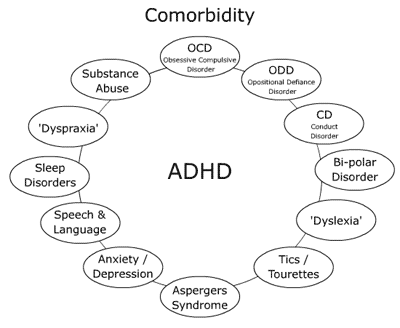ADHD
What is ADHD?
ADHD stands for Attention Deficit (Hyperactivity) Disorder. It is a neuro-developmental condition, so it develops as your brain develops, in childhood. It is often associated with (co-morbid with, as doctors put it), other neurodevelopmental conditions such as dyspraxia, dyslexia, Tourette’s syndrome and what are generally called autistic spectrum disorders.
These co-morbidities can easily mask or counteract some of the more obvious symptoms of ADHD, and an experienced psychiatrist will be well aware of this.
As well as being a neuro-developmental condition, in adults, ADHD is also commonly linked or co-morbid with mental health conditions such as anxiety or depression, where the underlying ADHD has been masked for years by the associated problems that it has resulted in.
A truly shocking statistic is that around 40% of those in prison reach the threshold for diagnosis of adult ADHD and most adults with undiagnosed ADHD will have developed and often sought help for other social problems and mental health conditions.
3 Recognised Sub-types of ADHD
1. Hyperactive – Normally associated with impulsive behaviour and that commonly perceived lack of control in children that has allowed some to dismiss the diagnosis as just bad behaviour and the result of poor parenting. The hyperactive behaviour tends to become more easily controlled as a child goes through adolescence – and to become a more generalised restlessness and or irritability. This is perhaps why there used to be a belief that ADHD was only found in children. In the last 20 years we have understood that this is not really true.
2. Inattentive – Which is now more commonly known as ADD. Where sufferers mainly experience difficulties staying focused and attending to daily, mundane tasks without being distracted, perhaps moving from one activity to another or becoming bored quickly. In children this is often missed as the resulting behaviour – daydreaming, inattentiveness, underachievement, can be dismissed as laziness or even praised as imaginative but unfulfilled potential.
2. Combined – As the name suggests, where there is a combination of inattention and hyperactivity. In most cases, this is probably the best description of most people with ADHD as they really have a spectrum of types of behaviour, any of which, on their own, could be regarded as quite “normal”, but which when part of a larger picture, lead to a diagnosis of ADHD.
Common Perceptions and Misunderstandings about ADHD
That common perception of ADHD; of badly behaved little boys being disruptive in class, is a huge element of the stereotypical prejudice in how many parents and teachers react to a diagnosis or even a suggestion that a diagnosis should be considered for their child.
The familiar perception is of the most visible sign of ADHD which is at its most florid in young boys. Young girls (and older ones), can also have ADHD but are less likely to be diagnosed, both because they show less hyperactivity and because the present statistics show that ADHD is more prevalent among boys by a factor or about 2 or 3 to 1 – (though this may be partly due to these historic prejudices.)
This common (mis)understanding of Attention Deficit Hyperactivity Disorder often leads to treatment of the condition with stimulants which are chemically similar to some recreational drugs – and which can have adverse effects on those without the condition. It is important to note that they do not give the sort of “rush” that those who use stimulants recreationally desire.
In fact, the medication has positive effects for over 80% of those with ADHD who try them. They are not addictive, whereas those with untreated ADHD are highly vulnerable, as they become adults, to succumbing to addiction – often by using illegal drugs to self-medicate. The research evidence is that medicating for ADHD actually reduces substance abuse.
ADHD Treatment (First Steps)
If you think you have ADHD, the first step to getting treatment is to receive a diagnosis from a specialist doctor. This is generally a psychiatrist with considerable experience of working in the field of neurodevelopmental conditions.
Although ADHD is usually a lifelong condition, it is also a very treatable condition – 80% of people with ADHD respond very positively to medication and, with better understanding of the condition, can usually learn to manage the difficulties that they would otherwise face. However, only with a specialist diagnosis can these medications be accessed. Whilst ADHD medications are highly effective, they are stimulants which are “controlled” drugs. You need a special type of prescription from a specialist ADHD clinician. GP’s typically continue to prescribe these, provided a specialist ADHD clinician has made a formal diagnosis of ADHD, and you are stable on your ADHD treatment.
Even with a diagnosis from a specialist psychiatrist, not all GP’s will agree to prescribe ADHD medication. It is advisable to discuss with your GP whether they will help, before booking an appointment with us. We will always do our best to help you to get your GP to work with us in a shared care model.
